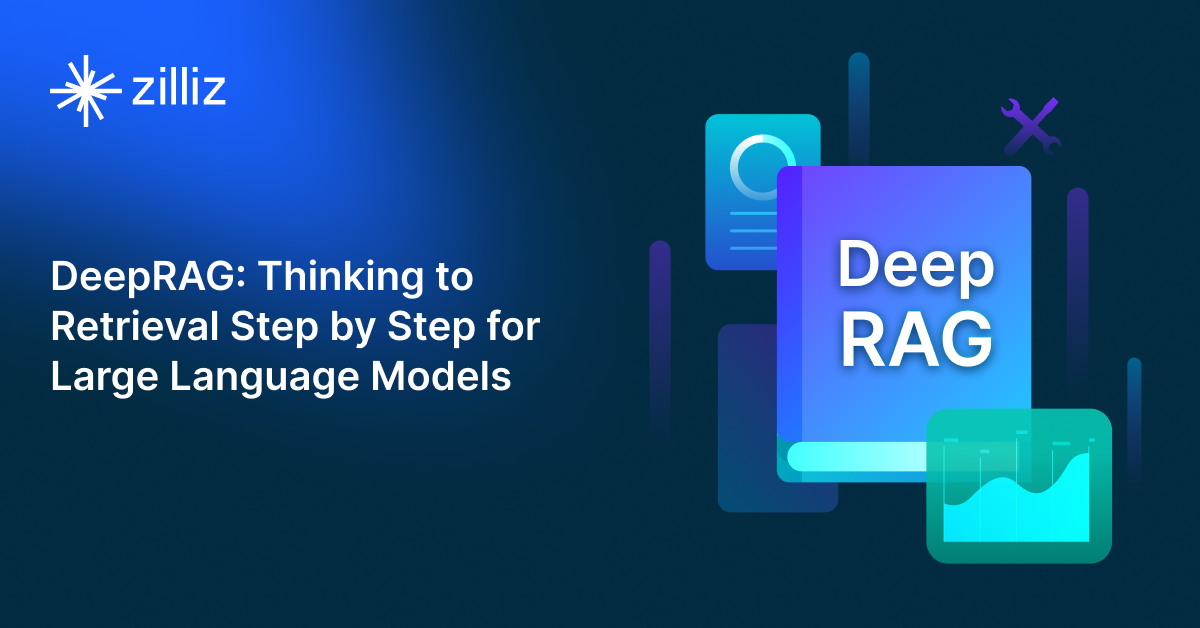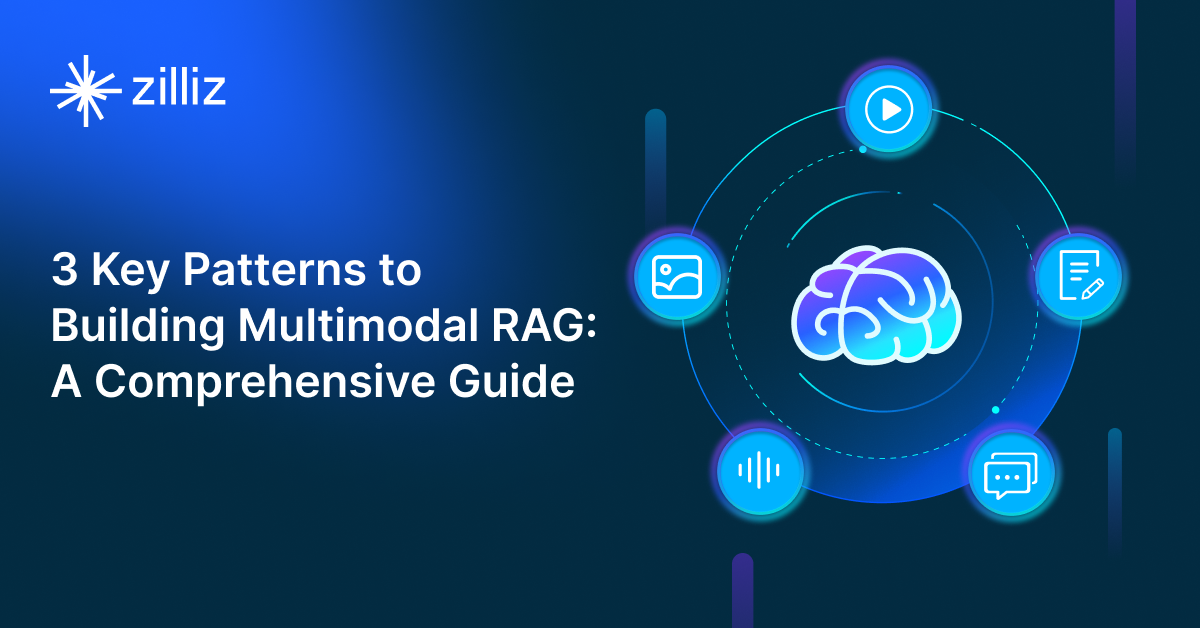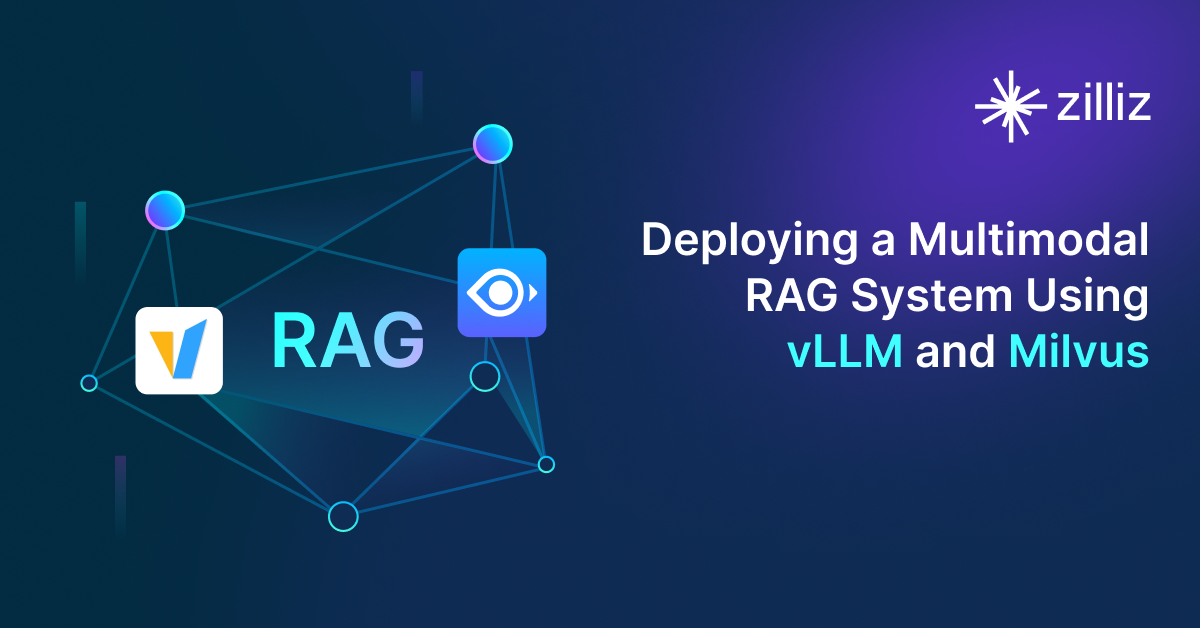Build RAG Chatbot with Haystack, Zilliz Cloud, Google Vertex AI Gemini 2.0 Flash Thinking, and BAAI bge-m3
Introduction to RAG
Retrieval-Augmented Generation (RAG) is a game-changer for GenAI applications, especially in conversational AI. It combines the power of pre-trained large language models (LLMs) like OpenAI’s GPT with external knowledge sources stored in vector databases such as Milvus and Zilliz Cloud, allowing for more accurate, contextually relevant, and up-to-date response generation. A RAG pipeline usually consists of four basic components: a vector database, an embedding model, an LLM, and a framework.
Key Components We'll Use for This RAG Chatbot
This tutorial shows you how to build a simple RAG chatbot in Python using the following components:
- Haystack: An open-source Python framework designed for building production-ready NLP applications, particularly question answering and semantic search systems. Haystack excels at retrieving information from large document collections through its modular architecture that combines retrieval and reader components. Ideal for developers creating search applications, chatbots, and knowledge management systems that require efficient document processing and accurate information extraction from unstructured text.
- Zilliz Cloud: a fully managed vector database-as-a-service platform built on top of the open-source Milvus, designed to handle high-performance vector data processing at scale. It enables organizations to efficiently store, search, and analyze large volumes of unstructured data, such as text, images, or audio, by leveraging advanced vector search technology. It offers a free tier supporting up to 1 million vectors.
- Google Vertex AI Gemini 2.0 Flash: A lightweight, high-speed AI model optimized for rapid inference and scalable tasks. It excels in real-time applications requiring low latency and cost-efficiency, such as chatbots, content summarization, and data processing. Ideal for enterprises needing fast, reliable outputs without compromising performance in high-throughput environments.
- BAAI bge-m3: A multilingual embedding model optimized for dense retrieval and semantic representation across 100+ languages. It excels in handling long texts, multi-task learning, and cross-lingual applications, offering high accuracy and scalability. Ideal for multilingual search engines, content recommendation systems, and enterprise-grade text analysis requiring robust semantic understanding.
By the end of this tutorial, you’ll have a functional chatbot capable of answering questions based on a custom knowledge base.
Note: Since we may use proprietary models in our tutorials, make sure you have the required API key beforehand.
Step 1: Install and Set Up Haystack
import os
import requests
from haystack import Pipeline
from haystack.components.converters import MarkdownToDocument
from haystack.components.preprocessors import DocumentSplitter
from haystack.components.writers import DocumentWriter
Step 2: Install and Set Up Google Vertex AI Gemini 2.0 Flash Thinking
Using theVertexAIGeminiGenerator with Haystack requires authentication using Google Cloud Application Default Credentials (ADCs). This means your application must be set up with credentials that allow it to access Google Cloud services. If you're not sure how to configure ADCs, check the official Google documentation for setup instructions.
It's important to use a Google Cloud account that has the right permissions to access a project with Google Vertex AI endpoints. Without proper access, the generator won’t work as expected.
To find your project ID, you can either look it up in the Google Cloud Console under the resource manager or run the following command in your terminal.
Now let's install and set up this model.
pip install google-vertex-haystack
from haystack_integrations.components.generators.google_vertex import VertexAIGeminiGenerator
generator = VertexAIGeminiGenerator(model="gemini-2.0-flash-thinking-exp-01-21")
Step 3: Install and Set Up BAAI bge-m3
from haystack import Document
from haystack.components.embedders import SentenceTransformersDocumentEmbedder
from haystack.components.embedders import SentenceTransformersTextEmbedder
doc_embedder = SentenceTransformersDocumentEmbedder(model="BAAI/bge-m3")
doc_embedder.warm_up()
text_embedder = SentenceTransformersTextEmbedder(model="BAAI/bge-m3")
text_embedder.warm_up()
Step 4: Install and Set Up Zilliz Cloud
pip install --upgrade pymilvus milvus-haystack
from milvus_haystack import MilvusDocumentStore
from milvus_haystack.milvus_embedding_retriever import MilvusEmbeddingRetriever
document_store = MilvusDocumentStore(connection_args={"uri": ZILLIZ_CLOUD_URI, "token": ZILLIZ_CLOUD_TOKEN}, drop_old=True,)
retriever = MilvusEmbeddingRetriever(document_store=document_store, top_k=3)
Step 5: Build a RAG Chatbot
Now that you’ve set up all components, let’s start to build a simple chatbot. We’ll use the Milvus introduction doc as a private knowledge base. You can replace it your own dataset to customize your RAG chatbot.
url = 'https://raw.githubusercontent.com/milvus-io/milvus-docs/refs/heads/v2.5.x/site/en/about/overview.md'
example_file = 'example_file.md'
response = requests.get(url)
with open(example_file, 'wb') as f:
f.write(response.content)
file_paths = [example_file] # You can replace it with your own file paths.
indexing_pipeline = Pipeline()
indexing_pipeline.add_component("converter", MarkdownToDocument())
indexing_pipeline.add_component("splitter", DocumentSplitter(split_by="sentence", split_length=2))
indexing_pipeline.add_component("embedder", document_embedder)
indexing_pipeline.add_component("writer", DocumentWriter(document_store))
indexing_pipeline.connect("converter", "splitter")
indexing_pipeline.connect("splitter", "embedder")
indexing_pipeline.connect("embedder", "writer")
indexing_pipeline.run({"converter": {"sources": file_paths}})
# print("Number of documents:", document_store.count_documents())
question = "What is Milvus?" # You can replace it with your own question.
retrieval_pipeline = Pipeline()
retrieval_pipeline.add_component("embedder", text_embedder)
retrieval_pipeline.add_component("retriever", retriever)
retrieval_pipeline.connect("embedder", "retriever")
retrieval_results = retrieval_pipeline.run({"embedder": {"text": question}})
# for doc in retrieval_results["retriever"]["documents"]:
# print(doc.content)
# print("-" * 10)
from haystack.utils import Secret
from haystack.components.builders import PromptBuilder
retriever = MilvusEmbeddingRetriever(document_store=document_store, top_k=3)
text_embedder = SentenceTransformersTextEmbedder(model="BAAI/bge-m3")
text_embedder.warm_up()
prompt_template = """Answer the following query based on the provided context. If the context does
not include an answer, reply with 'I don't know'.\n
Query: {{query}}
Documents:
{% for doc in documents %}
{{ doc.content }}
{% endfor %}
Answer:
"""
rag_pipeline = Pipeline()
rag_pipeline.add_component("text_embedder", text_embedder)
rag_pipeline.add_component("retriever", retriever)
rag_pipeline.add_component("prompt_builder", PromptBuilder(template=prompt_template))
rag_pipeline.add_component("generator", generator)
rag_pipeline.connect("text_embedder.embedding", "retriever.query_embedding")
rag_pipeline.connect("retriever.documents", "prompt_builder.documents")
rag_pipeline.connect("prompt_builder", "generator")
results = rag_pipeline.run({"text_embedder": {"text": question}, "prompt_builder": {"query": question},})
print('RAG answer:\n', results["generator"]["replies"][0])
Optimization Tips
As you build your RAG system, optimization is key to ensuring peak performance and efficiency. While setting up the components is an essential first step, fine-tuning each one will help you create a solution that works even better and scales seamlessly. In this section, we’ll share some practical tips for optimizing all these components, giving you the edge to build smarter, faster, and more responsive RAG applications.
Haystack optimization tips
To optimize Haystack in a RAG setup, ensure you use an efficient retriever like FAISS or Milvus for scalable and fast similarity searches. Fine-tune your document store settings, such as indexing strategies and storage backends, to balance speed and accuracy. Use batch processing for embedding generation to reduce latency and optimize API calls. Leverage Haystack's pipeline caching to avoid redundant computations, especially for frequently queried documents. Tune your reader model by selecting a lightweight yet accurate transformer-based model like DistilBERT to speed up response times. Implement query rewriting or filtering techniques to enhance retrieval quality, ensuring the most relevant documents are retrieved for generation. Finally, monitor system performance with Haystack’s built-in evaluation tools to iteratively refine your setup based on real-world query performance.
Zilliz Cloud optimization tips
Optimizing Zilliz Cloud for a RAG system involves efficient index selection, query tuning, and resource management. Use Hierarchical Navigable Small World (HNSW) indexing for high-speed, approximate nearest neighbor search while balancing recall and efficiency. Fine-tune ef_construction and M parameters based on your dataset size and query workload to optimize search accuracy and latency. Enable dynamic scaling to handle fluctuating workloads efficiently, ensuring smooth performance under varying query loads. Implement data partitioning to improve retrieval speed by grouping related data, reducing unnecessary comparisons. Regularly update and optimize embeddings to keep results relevant, particularly when dealing with evolving datasets. Use hybrid search techniques, such as combining vector and keyword search, to improve response quality. Monitor system metrics in Zilliz Cloud’s dashboard and adjust configurations accordingly to maintain low-latency, high-throughput performance.
Google Vertex AI Gemini 2.0 Flash optimization tips
To optimize Gemini 2.0 Flash in RAG, fine-tune input chunking to balance context relevance and token limits—aim for 512–1024 tokens. Use structured queries with explicit filters (e.g., metadata, date ranges) to improve retrieval precision. Adjust temperature (0.1–0.3) and top-p (0.7–0.9) to reduce hallucination while maintaining coherence. Cache frequent retrievals to minimize latency and costs. Preprocess documents to remove noise and enhance embeddings. Test hybrid search (keyword + vector) for complex queries. Monitor token usage and response quality via Vertex AI’s logging tools for iterative tuning.
BAAI bge-m3 optimization tips
To optimize BAAI bge-m3 in a RAG setup, fine-tune the model on domain-specific data to enhance retrieval relevance. Use dynamic chunking (e.g., 256-512 tokens) for balanced context capture and computational efficiency. Normalize embeddings before similarity scoring to reduce bias. Enable mixed-precision inference for faster processing without significant accuracy loss. Experiment with pooling strategies like CLS or mean-pooling for dense vectors. Regularly update the retrieval corpus to reflect new data, and apply batch processing during inference to maximize GPU utilization. Monitor embedding quality via recall@k metrics to refine parameters iteratively.
By implementing these tips across your components, you'll be able to enhance the performance and functionality of your RAG system, ensuring it’s optimized for both speed and accuracy. Keep testing, iterating, and refining your setup to stay ahead in the ever-evolving world of AI development.
RAG Cost Calculator: A Free Tool to Calculate Your Cost in Seconds
Estimating the cost of a Retrieval-Augmented Generation (RAG) pipeline involves analyzing expenses across vector storage, compute resources, and API usage. Key cost drivers include vector database queries, embedding generation, and LLM inference.
RAG Cost Calculator is a free tool that quickly estimates the cost of building a RAG pipeline, including chunking, embedding, vector storage/search, and LLM generation. It also helps you identify cost-saving opportunities and achieve up to 10x cost reduction on vector databases with the serverless option.
 Calculate your RAG cost
Calculate your RAG cost
What Have You Learned?
By diving into this tutorial, you’ve unlocked the magic of building a RAG system from scratch! You discovered how Haystack acts as the orchestration powerhouse, seamlessly coordinating the flow of data and queries between components. Zilliz Cloud stepped in as your scalable vector database hero, storing and retrieving embeddings at lightning speed, ensuring your system handles large datasets without breaking a sweat. Then came Google Vertex AI Gemini 2.0 Flash, the brains behind the operation, generating human-like responses with remarkable efficiency—proving that speed and quality can coexist in an LLM. And let’s not forget the BAAI bge-m3 embedding model, which transformed your raw text into rich, context-aware vectors, capturing nuances even across multiple languages. Together, these tools formed a dynamic pipeline where each piece plays a critical role: ingesting data, creating embeddings, storing them intelligently, and generating answers that feel almost telepathic!
But wait—there’s more! You also picked up pro tips for optimizing performance, like tuning chunk sizes and filtering metadata to balance speed and accuracy. Plus, the free RAG cost calculator gave you a crystal ball to predict expenses before scaling up. Now that you’ve seen how these pieces fit together, imagine the possibilities: chatbots that understand deeply, search engines that read minds, or personalized AI assistants that feel like extensions of yourself. The tools are in your hands, the foundation is laid—it’s time to build, experiment, and innovate. Whether you’re refining your first prototype or dreaming up the next big thing in AI, remember: every line of code you write brings us closer to a smarter, more connected world. Let’s go make it happen! 🚀
Further Resources
🌟 In addition to this RAG tutorial, unleash your full potential with these incredible resources to level up your RAG skills.
- How to Build a Multimodal RAG | Documentation
- How to Enhance the Performance of Your RAG Pipeline
- Graph RAG with Milvus | Documentation
- How to Evaluate RAG Applications - Zilliz Learn
- Generative AI Resource Hub | Zilliz
We'd Love to Hear What You Think!
We’d love to hear your thoughts! 🌟 Leave your questions or comments below or join our vibrant Milvus Discord community to share your experiences, ask questions, or connect with thousands of AI enthusiasts. Your journey matters to us!
If you like this tutorial, show your support by giving our Milvus GitHub repo a star ⭐—it means the world to us and inspires us to keep creating! 💖
- Introduction to RAG
- Key Components We'll Use for This RAG Chatbot
- Step 1: Install and Set Up Haystack
- Step 2: Install and Set Up Google Vertex AI Gemini 2.0 Flash Thinking
- Step 3: Install and Set Up BAAI bge-m3
- Step 4: Install and Set Up Zilliz Cloud
- Step 5: Build a RAG Chatbot
- Optimization Tips
- RAG Cost Calculator: A Free Tool to Calculate Your Cost in Seconds
- What Have You Learned?
- Further Resources
- We'd Love to Hear What You Think!
Content
Vector Database at Scale
Zilliz Cloud is a fully-managed vector database built for scale, perfect for your RAG apps.
Try Zilliz Cloud for Free


